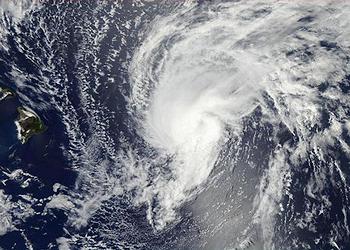
HONOLULU, Hawaii, July 29, 2013 (ENS) – Tropical Storm Flossie is bringing heavy rains, strong winds and big waves to the main Hawaiian Islands today through Tuesday. But the worst is yet to come. The state’s newly updated Ocean Resources Management Plan projects much larger storm surges and higher wind velocities for Hawaii as the planet warms.
At 11 am local time, the storm was packing maximum sustained winds of 40 mph. It was 200 miles east-southeast of Honolulu, moving west-northwest at 18 mph. Tropical Storm force winds extend outward up to 70 miles from the center. The Honolulu International Airport is open and flights are on time, according to the Federal Aviation Administration.

The storm, which is expected to weaken further, will become a tropical depression when its maximum sustained winds fall below 39 mph.
Tom Evans, of the National Weather Service, said this morning that while the storm is weakening it still is expected to bring thunderstorms, dangerous surf, heavy rains, storm surges and flooding to parts of the state through Tuesday night.
Governor Neil Abercrombie has proclaimed a State of Emergency covering the entire state, and the U.S. Coast Guard has closed the ports of Hilo and Kawaihae on the Big Island and Kahului, Maui to all traffic as of midnight Sunday.
Captain Shannon Gilreath, the Coast Guard Captain of the Port, has set Heavy Weather Condition II for these ports and is urging local mariners to review their heavy weather plans and to remain vigilant to forecasts for Tropical Storm Flossie.
“While we have not set conditions for the other ports, you should still exercise caution and prudence in conducting your operations,” said Gilreath. “Know your capabilities and your constraints and adhere to them so that we can all continue to operate safely.”
The Department of Land and Natural Resources has closed many trails, parks, and campground areas effective immediately. “We advise that hikers, campers or hunters should avoid trails, streams and back-country areas under these conditions,” said DLNR chairperson William J. Aila, Jr. “Due to the high surf and heavy rains that may occur under storm conditions the public is urged to avoid shorelines and areas near streams.”
Hawaii Electric Light Company saystrees blown over by gusty winds from Tropical Storm Flossie are causing power outages throughout the lower Puna area on the Big Island of Hawaii. The outages are affecting about 5,000 customers.
Taking a long-term view of ocean and climate conditions and storm surge risks, Governor Abercrombie Thursday signed an updated Hawaii Ocean Resources Management Plan that brings county, state and federal agencies together to guard against the effects of climate change and other threats to ocean water quality.
“Global warming is predicted to cause an increase in frequency and power of both storm surge and hurricanes,” the updated Plan states.
“The Hawaii Ocean Resources Management Plan is a comprehensive state plan that provides a framework for ocean and coastal resource management in Hawaii. It strives to achieve the delicate balance between economic, ecological, and cultural needs,” wrote Governor Abercrombie in his introduction to the updated plan.

“Where there is water, there is life. From rainfall in Hawaii’s mountains, through streams, rivers, and underground geological networks, to the ocean surrounding Hawaii, water influences all aspects of our lives,” the governor wrote.
“Climate change has been documented to have impacts on the atmosphere, coasts, and marine resources,” states the Plan. “Mitigation and adaptation to climate change and coastal hazards need to be addressed in order to combat the pressure that exist today, as well as prepare Hawaii for future impacts. Because of the cumulative impacts of climate change, the state has put a focus on adaptation.
The Plan cites a 2011 study that indicates wind velocity will increase by as much as 25 percent by the end of the 21st century, partially in response to the warming oceans.
“The Intergovernmental Panel on Climate Change states that a one-meter (39 inch) rise in sea level would enable a 15-year storm to flood areas that today are only flooded by a 100-year storm,” the Plan states. “Changes in precipitation, with heavier rainfalls, are also expected, which impact the amount of runoff from Hawaii’s watersheds.”
“It is essential that government agencies at all levels work together to address Hawaii’s resource challenges,” Abercrombie said. “Our lives are intertwined with the natural resources of these islands, from the local economy to our island way of life. This plan provides a clear roadmap for achieving a necessary balance between use and preservation.”
Last updated in 2006, the latest version of the Hawaii Ocean Resources Management Plan was developed with the participation of county, state and federal agencies responsible for the sustainable use and conservation of Hawaii’s ocean and coastal resources.
It identifies 11 management priorities for the next five years and pathways for achieving goals. The priorities are based on community outreach conducted in all four counties through public meetings, oral and written submissions, and social media.
Tracking the success of the plan will be coordinated with the state Office of Information Management and Technology to take advantage of the state’s data.hawaii.gov portal.
“The 11 management priorities address resource management challenges that can only be achieved through a statewide, coordinated effort among various government and community partners,” said Jesse Souki, director of Hawaii’s state Office of Planning, which is responsible for coordinating the periodic update of the plan.
“It addresses some of the greatest challenges of our time, including the impacts of climate change and balancing economic, cultural and environmental considerations to ensure sustainable stewardship of our resources,” said Souki.
The updated Plan leverages federal funding through the Hawaii Coastal Zone Management Program. Download a copy of the Plan at: http://planning.hawaii.gov/czm/ocean-resources-management-plan-ormp/
Copyright Environment News Service (ENS) 2013. All rights reserved.
